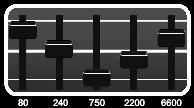Difference between revisions of "Mesa amp tips"
m (Edited the layout to work better with the tutorials page insert) |
m (Another reformat) |
||
| Line 1: | Line 1: | ||
| − | ====The Mark Series==== | + | ====The Mesa Mark Series==== |
Courtesy of Shredi Knight from the Fractal Audio Systems Forum | Courtesy of Shredi Knight from the Fractal Audio Systems Forum | ||
| Line 59: | Line 59: | ||
<BR /> | <BR /> | ||
| − | ==== | + | ====The Mesa 2:90==== |
Cliff posted a cool trick to tighten up the low end on high gain patches. Some users have found that implementing this in conjunction with a boost to the transformer match parameter (on the advanced page of the amp block) yields a result similar to the "deep" or "deep extend" mode on the 2:90.<BR /> | Cliff posted a cool trick to tighten up the low end on high gain patches. Some users have found that implementing this in conjunction with a boost to the transformer match parameter (on the advanced page of the amp block) yields a result similar to the "deep" or "deep extend" mode on the 2:90.<BR /> | ||
<BR /> | <BR /> | ||
Revision as of 20:44, 8 November 2009
The Mesa Mark Series
Courtesy of Shredi Knight from the Fractal Audio Systems Forum
As far as the USA Lead sims (Mesa Mark series) go, I tend to approach them like the real things. Here's my list of tips:
- Keep the amp sim's Bass low. Anywhere from 0-4 is typical with Mesa users, with 2 seeming to be the most common. I have the Bass around 2.00 on my patches. Mid anywhere from 5.00 to 8.00, and Treble fairly high (from 6.50 to 8.50). I personally have the Treble on my patches between 6.50 - 7.50, depending on the USA Lead sim. This is how the Mesa Mark series amps are typically set up. I also have the Presence at 2.52 (between 2-3 seems typical on real world settings). I have the Tonestack Type set to Passive and the Presence Type set to Active.
- Keep the power amp Master relatively low so most of the gain is coming from the preamp stage of the amp sim. Mesas are about preamp distortion, not power amp distortion. Typical settings I've seen on the Mark series are between 3-4 (I set the Master at 3.23).
- Mesas are set with a very cold, fixed bias. I've researched this a lot and the consensus seems to be that it is 200-205, so you might experiment with turning the amp sim's Pwr Tube Bias parameter down (I have mine at 0.205).
- This isn't specific to just the Mesas, but to the high gain amp sims in general: Try turning up the Transformer Match parameter. I read where someone on another forum described it as the "Mojo" control, and that's pretty accurate. I can't describe too well what it does to the tone, it just makes it sound better. More lively and 3-D sounding. I set it at 6.38 on the USA Lead 1, and 6.85 on all the other Mesa Mark sims.
- Use the Parametric EQ after the amp sim to simulate the Mesa Mark's on-board graphic eq and the Mesa "Classic V" eq curve:
The supposed real frequencies and Q's can be found on the Axe FX Wiki, but I never liked how they sounded. I just use the actual frequencies as they appear on the front of the Mesa amps (like in the above pic) with the Parametric's default Q's (with a couple of exceptions) and it sounds pretty close to me (I can give you the exact settings I use if you want).
- I always use a Drive block before the amp sim (all high gain amp sims, not just the USA Leads) to tighten up the bass and give the tone more punch (Drive at 0.00, Level 10.00). I like to use the Full OD, with the Clip Type changed to HV Tube.
Here's the settings I use for the Parametric EQ on my Mark IV patch. It goes directly after the Amp block:
Parametric EQ:
F1 Freq. 80.8 Hz Q. 8.12 Gain. 8.79 dB Type. Shelving
F2 Freq. 238.8 Hz Q. 0.707 Gain. (minus) -0.47 dB
F3 Freq. 748.2 Hz Q. 0.718 Gain. (minus) -7.46 dB
F4 Freq. 2181 Hz Q. 0.707 Gain. 2.36 dB
(I don't actually use this next freq, but included it because I'm an anal completest.)
F5 Freq. 6618 Hz Q. 0.707 Gain. 0.00 dB Type. Shelving
One very important thing is to use the Amp blocks Depth control. I use this instead of boosting the 238.8 Hz frequency in the Parametric EQ. Experiment with turning it up until you get the desired amount of "Thump". On my Mark IV patch the Depth is at 6.69, and is set to Active on the advanced amp page.
The Mesa 2:90
Cliff posted a cool trick to tighten up the low end on high gain patches. Some users have found that implementing this in conjunction with a boost to the transformer match parameter (on the advanced page of the amp block) yields a result similar to the "deep" or "deep extend" mode on the 2:90.
1. Put a filter block before the amp block. Set the type to Highpass.
2. Attach the Envelope controller to the Frequency parameter. Use default settings for the Envelope parameters.
3. Set the Scale to 40%, Offset to around 22%.
